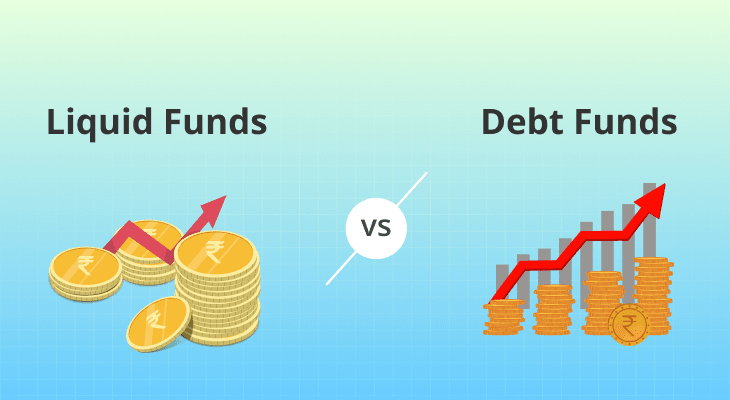
Table of content
Liquid Funds vs Debt Funds: A Comprehensive Comparison
Mutual fund investments have gained widespread popularity in India. This has brought upon a wide range of funds and types to choose from. Liquid Funds and Debt Funds are two such types that have their own set of advantages and limitations. To make the right choice, you need to first understand and then compare between liquid funds vs debt funds. Let us help you in this exercise. Our guide will dive into the specifics of each and highlight key differences between liquid and debt funds to help you in making informed investment decisions.
Understanding Liquid Funds
Liquid funds are designed for short-term investments. They primarily focus on instruments with shorter maturities that in turn deliver higher liquidity. They predominantly invest in money market instruments, commercial papers, and treasury bills with maturities of up to 91 days. The short maturity period is a key characteristic of liquid funds, ensuring high liquidity and minimal interest rate risk. Unlike other mutual funds, liquid funds aim for stability and safety, making them an ideal choice for investors seeking liquidity with minimal risk.
Key Features of Liquid Funds
Liquidity
Quick and easy redemption, ensuring access to funds when needed.
Stable NAV
Maintains a low and stable Net Asset Value (NAV).
Low Volatility
Invests in low-risk, short-term instruments, minimising market-related fluctuations.
Ideal For Short-Term Goals
Suited for parking surplus funds or fulfilling short-term financial objectives.
Benefits of Liquid Funds
Quick Access To Funds
High liquidity allows for swift redemption making them an ideal choice for emergencies or for parking surplus cash.
Capital Preservation
Focus on low-risk instruments ensures the preservation of invested capital.
Stability
Stable NAV provides a sense of security for risk-averse investors.
Key Features of Liquid Funds
Lower Returns
Liquid funds generally offer lower returns compared to other mutual funds due to the conservative investment approach.
Market Fluctuations
While the market-related effect is quite low, liquid funds aren't entirely immune to market fluctuations. It is important to read all the risks carefully before investing.
Understanding Debt Funds
On the other side of the spectrum, debt funds present a broader horizon. These funds traverse a diverse landscape of debt instruments, encompassing government securities, corporate bonds, and debentures. The objective is to generate steady income while managing risk through strategic diversification across various debt avenues.
Key Features of Debt Funds
Diverse Portfolio
Invests in a variety of debt instruments with varying maturities, enhancing diversification.
Potential For Higher Returns
Offers the potential for higher returns compared to liquid funds.
Risk Management
Diversification helps manage risks associated with specific debt instruments.
Benefits of Debt Funds
Steady Income
Regular interest payouts make debt funds suitable for income generation.
Diversification
Spreads risk across various debt instruments, reducing concentration risk.
Tax Efficiency
For investments made prior to March 31, lower tax slab for long-term capital gains after three years along with indexation benefits.
Key Features of Debt Funds
Market Risks
Subject to market fluctuations, impacting the fund's NAV.
Interest Rate Risks
Sensitivity to changes in interest rates, affecting bond prices.
Debt vs Liquid Funds: A Comparison
As an investor, knowing the differences between liquid and debt funds is crucial for making the right choice that is aligned with your financial goals. From risk factors to liquidity and return potential, here’s a side-by-side comparison between the two:
| Factor | Liquid Funds | Debt Funds |
|---|---|---|
| Investment Horizon | Short-term | Short to Medium-term |
| Primary Instruments | Money Market Instruments | Government Securities, Corporate Bonds |
| Maturity Period | Up to 91 days | Varies based on the portfolio |
| Risk Profile | Low | Moderate to Low |
| Potential for Returns | Lower | Moderate |
| NAV Stability | Stable | Subject to Market Fluctuations |
| Ideal for | Emergency Funds, Short-term Goals | Steady Income, Moderate Risk |
Liquid Funds vs Debt Funds: What’s Right For You?
In summary, understanding the subtle distinctions in features, benefits, and limitations allows you to evaluate your options strategically. Whether aiming for short-term liquidity with liquid funds or seeking a balanced income-risk equation with debt funds, this guide serves as a compass, aiding in the selection of an investment path aligned with individual goals. Remember, the key lies not just in choosing between liquid and debt funds but in aligning your investment strategy with your unique financial landscape.
SIPs let you invest small amounts regularly, making it easier to stay consistent with your goals. With time, your money grows faster through compounding, helping you get the most out of your investments. Try our SIP Calculator to see how your money can grow and make smarter plans for your future.
FAQ
Are liquid funds and debt funds the same?
No, they differ. While both are types of mutual funds, liquid funds focus on short-term debt instruments for liquidity, while debt funds have a broader portfolio with varying maturity periods.
What is the primary difference between liquid and debt funds?
The key distinction lies in their investment objectives. Liquid funds prioritise liquidity and safety, typically investing in very short-term instruments, while debt funds have a broader mandate, spanning various debt instruments.
Which is riskier, liquid funds, or debt funds?
Liquid funds are generally considered lower risk due to their focus on short-term instruments. Debt funds, depending on their portfolio, may carry slightly higher risk, especially with exposure to longer-term securities.
How do returns compare between liquid and debt funds?
Returns vary based on market conditions. Liquid funds aim for stability, offering relatively lower returns, while debt funds, with exposure to a diverse debt portfolio, may provide slightly higher returns.
Can I use liquid funds for long-term goals?
While designed for short-term needs, some investors use liquid funds for parking funds temporarily during market volatility. However, they might not offer optimal returns for long-term wealth creation.
Which fund is more suitable for emergency funds?
Debt funds enjoy tax benefits for long-term capital gains after three years. However, short-term gains are taxed as per the investor's income tax slab, making them tax-efficient for certain investment horizons.


